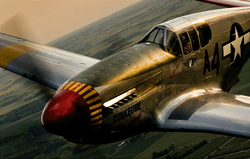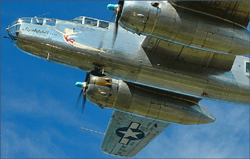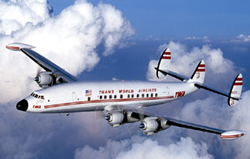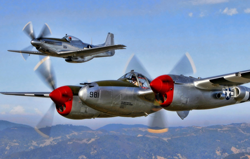Mustang

Manufacturer: North American Aviation
Primary Role: Fighter
- Description:
- Specifications:
When North American Aviation President "Dutch" Kindleberger approached Sir Henry Self of the British Supply Committee for the sale of the B-25 Mitchell bombers in 1939, Self responded with a more urgent need for fighters. Self initially asked if North American could produce the Curtiss P-40 Tomahawk fighters under license, but Kindleberger responded negatively. Instead, he promised, North American was to deliver a better design, and in less time than what the company would need to gear a new production line for the manufacturing of the Tomahawk design. By Mar 1940, the British ordered 320 of the new fighters: the P-51 Mustang. On 26 Jun 1940, production was expanded when Packard was given a license to build the design with a different, Rolls-Royce Merlin, engine.
It is interesting to note that, initially, the United States Army Air Corps blocked the sale of the new design to Britain due to its protectionist philosophies. Eventually, however, top Army leaders were convinced otherwise after North American promised that two examples would be given to the US Army at no cost.
The first prototype, designated NA-73X, took flight on 26 Oct 1940, merely 117 days after the order was placed. It handled well, and most significantly, offered a long range with its high fuel load. It also had room to house heavier armament than the British Spitfire fighters. The first design suffered some performance drawbacks at high altitudes, but otherwise it still impressed RAF Air Fighter Development Unit's commanding officer.
The first combat action the Mustang fighters participated took place on 10 May 1942, when RAF pilots flew them against German counterparts.
In early 1943, a new Mustang design went into production. Designated Mustang X during prototype stages and P-51B and P-51C Mustang III after production began, these P-51 Mustang fighters equipped with Rolls-Royce Merlin 61 engines had much better performance in high altitudes, something the prior variants lacked. One improvement that had longer lasting effect was the possibility of a drop tank in these Merlin-equipped fighters, which provided the Allies candidates for long-range bomber escorts. Many of these new fighters began arriving in Britain in Aug 1943, while fewer numbers went to Italy late that year. By late 1943, they were the favored fighters to escort bombers on bombing missions deep into Germany. Their high speed also allowed them to pursue German V-1 rockets.
The next stage of development resulted in the P-51D variant, which was considered the definitive Mustang model; bubble canopies that provided much greater field of vision and six M2 machine guns were the key characteristics of the P-51D fighters. When these fighters arrived in Europe in mid-1944, they quickly became the United States Army Air Forces' primary fighters. This variant would also become the most widely produced variant of the Mustang design. By the end of 1944, 14 out of the 15 groups of the US Army 8th Air Force flew Mustang fighters of various variants. American pilot Chuck Yeager of later test pilot fame flew a P-51D Mustang fighter at this time, skillfully shooting down a German Me 262 jet fighter during its landing approach, making him the first American to shoot down a German jet fighter.
Two American pilots flying P-51 fighters were awarded the Medal of Honor during WW2, Major James H. Howard of the 354th Fighter Group for action over Germany on 11 Jan 1944 and Major William A. Shomo of the 82nd Tactical Reconnaissance Squadron for action over the Philippine Islands on 11 Jan 1945.
By late 1944, P-51 Mustang fighters were seen in the China-Burma-India Theater as well. They operated in both ground support and bomber escort roles.
The P-51H variant entered production just before the end of the war, yielding 555 of the fastest production Mustang fighters built, but none of them saw combat during WW2. Because of the lower availability of spare parts, most P-51H fighters would not see much action even during the Korean conflict, unlike their P-51B, C, and D siblings.
After WW2, P-51 Mustang fighters were selected as the main propeller-driven fighter of the US Army Air Forces, but the advent of jet fighters had already eclipsed the design. Nevertheless, they remained in service in 30 countries around the world, and remained in production in the form of a license-built variant by the Commonwealth Aircraft Corporation in Australia until 1948. By 1950, most of the American P-51 fighters, now designated F-51 under a new designation system in the US, were relegated to Air National Guard units. During the Korean War, many F-51 fighters were used as tactical ground attack aircraft and reconnaissance aircraft, particularly of the F-51D variant. After the North Korean push that nearly conquered all of South Korea, F-51 Mustang fighters could actually reach targets that their jet counterparts could not.
After the Korean War, the United States continued to employ Mustang aircraft until 1957, then again after 1967 with Mustang aircraft built by Cavalier Air Corporation, which had purchased the design rights from North American in the early 1960s. The last US military use of the F-51 aircraft was in 1968, when the US Army used them as chase aircraft during the development of the YAH-56 Cheyenne helicopter. Many of them continued to be in service abroad, with the Dominican Republic Air Force being the last to retire them, in 1984.
Mustang aircraft were sold to the civilian market as early as immediately after WW2, some for as little as US$1,500. Many of them entered air racing, such as the P-51C aircraft purchased by Paul Mantz, who won the Bendix Air Races in 1946 and 1947 and set a US coast-to-coast record in 1947. Today, Mustang aircraft are among the most sought after "warbird" aircraft on the civilian market, with some transactions exceeding US$1,000,000.
In total, 15,875 units were built, making the P-51 Mustang design the second most-built aircraft in the United States after the P-47 Thunderbolt.
Length: 9.83 m
Height: 4.17 m
Powerplant: One Packard Merlin V-1650-7 liquid-cooled supercharged V-12
Cruising Speed: 580 km/h
Maximum Speed: 703 km/h



